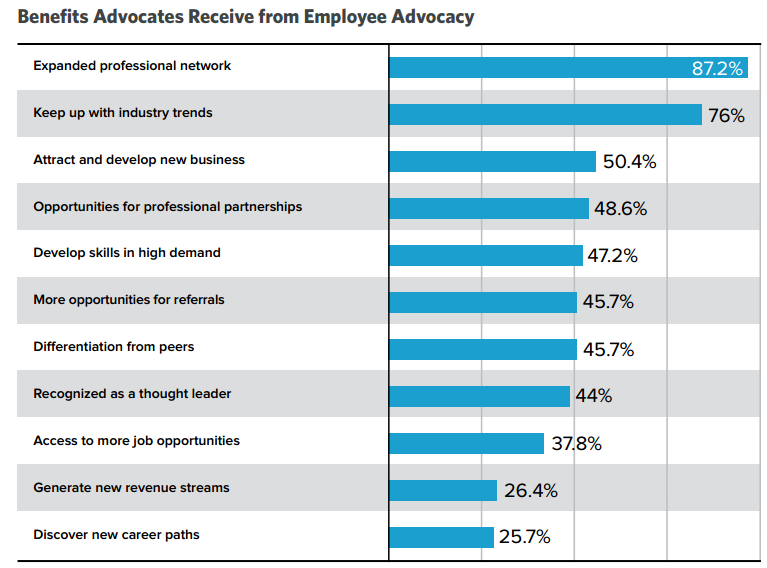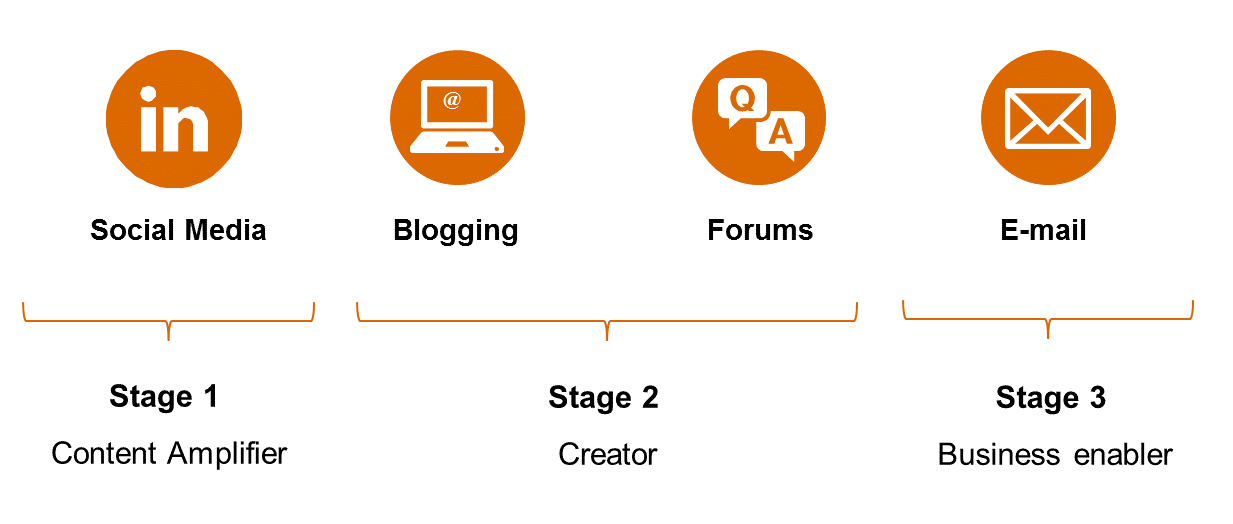Employee advocacy isn’t a new concept but It has become a recurring conversation subject among HR, Marketing and Communications professionals in different industries. Is it really worth investing in? As in other aspects of our lives, digital technology has done a good job boosting employee advocacy, making it mainstream. While we could list initiatives that fall into the scope prior to 2016, this is the year when we started taking our first coordinated actions. Not always easy to walk, the path until now has been an invaluable learning experience, where legacy, digital readiness, content strategy and trust have a say. Among the ideas and lessons learnt we share with you in this article, there is one particularly valuable for any business in the financial services industry betting on an employee advocacy programme. Let’s get started!
The Employee Advocacy definition we like
Among dozens of employee advocacy definitions, we have chosen the one that fits best into our way of thinking:
“Employee advocacy” describes any action our people take to advocate for our company, advancing their personal brand and promoting our values and expertise.
We prefer to keep it broad and inclusive, because our People’s advocacy actions can happen either online or offline although channels such as social media are largely used to implement these programmes. We value our People’s power to “humanise” our brand and our content; we’re aware of the fact that we, as professionals, trust peers more than brands.
A successful employee advocacy initiative cannot be purely transactional and must place engagement as the top priority. An approach where “we ask you to advocate, please do” or “we encourage you to share this content” are common demands may work, but only in the short term. Showing employees the benefits of becoming ambassadors of your brand, and clearly stating “what it is in it for them” is the cornerstone for any employee advocacy initiative that aims at long-term success.
Once the benefits of becoming a brand ambassador are understood, the challenge is to make this practice a habit, at least over certain period. Engagement is the time your employees spend advocating for your brand. Based on our experience, user-friendly accessible technology (especially when your focus is on digital), meaningful content and periodic offline gatherings are three aspects you want to bear in mind for engagement. Regarding the latter one, inviting your people to a nice place to listen to their experiences, exchange anecdotes, get their feedback, discover their pain points and, simply, share an intimate moment, makes a world of a difference to keep the advocacy flame.

About our employee advocacy programme
We chose to put in place a digital one. Everybody has a smartphone, therefore, access to apps; most people use social media on a daily basis, becoming a powerful channel for content distribution; we’re committed to create more powerful digital content.
We have a clear vision for our advocates, our best brand ambassadors. We don’t want them to be “content amplifiers-only”, but creators and enablers instead. We’ve put together this scheme to visualise the path we want our employee advocacy to follow, and the preferred channels where that can occur.

Five things we’ve learnt (so far) when running our employee advocacy programme
This list of recommendations is a work-in-progress. To build it up, we gathered in front of a board with colourful markers, a bunch of post-its and some coffee. The result is a humble reflection we invite you to consider when implementing your employee advocacy programme:
1) Define a simple but necessary governance model
Guidelines, roles and accountability: an employee advocacy programme needs them, as any other initiative that involves employees across different departments. It doesn’t need to be fancy, neither a complex legal-like document, hard to understand. It should be friendly enough for every participant in the programme to get the message through. Creating an infographic or a short video with the main ideas is pretty impactful.
Choose a professional or a team to “own” the programme and be accountable for it. They become the champions, the advocates of the advocates, the people who play a pivotal role to get the board involved and to guarantee the initiative moves forward.
2) Run it in a “pilot mode” first or consider it as a “beta version”
This recommendation speaks for itself. Like the ones tech giants are used to run when experimenting new features, beta versions let you set the scene. They help you understand the participation dynamics of your advocates. They adjust the time your team responsible for the programme must allocate, outline your content strategy and determine the need of information or content flows. If your company is organised in units or industries like ours, you want to guarantee there’s content that satisfies various interests. This is one of the main challenges you will encounter.
3) Keep a growth hacking-like approach
The north of your programme is growth: make the digital presence of your people grow and help them establish their footprint as experts. On the other hand, your brand must also grow in exposure, recognition and leadership. Increased engagement, conversion and retention, all measurable variables, are the outcome of a growth hacking-like approach.
4) Put in place a “curriculum to become a powerful brand advocate”
We understand curriculum as a series of training and coaching sessions for your committed people to become better brand advocates. This influences engagement and help avoid or limit the “transactional” nature employee advocacy programmes tend to adopt, if their champions don’t pay close attention to. It also helps some employees get “digitally ready” and feel more comfortable when sharing content on social media, for example.
The scheme you saw above links to this curriculum idea. Content is key to developing the digital presence of your employees. When the programme matures and you’re ready to put in place a content collaboration process, make them part of the creation. The sense of appropriation is very powerful to boost engagement and allows your employees to feel connected to something bigger.
Also, pitch the idea of the importance of reading, sharing and commenting on content from sources other than your brand. You want your employees to get richer overview of the industry they work in.
5) Choose a user-friendly software with a not pronounced learning curve
It has to be mobile-friendly and interactive to let your people propose content, make comments, tailor social media messages and flag information that might be misleading.
A key aspect when implementing an employee advocacy programme in financial services
The lessons we shared are based on real experience. While implementing our employee advocacy programme, we’ve encountered some others, but there is a constraint we’re still going over. We understand it’s part of a legacy system related to the industries we serve, mostly in financial services.
In fact, it’s the lack of confidence a considerable amount of professionals have to give an opinion, to express a point of view, to elaborate on others’ ideas, contrast them or enrich them, to stand for a cause.
Most professionals in the financial services face regulatory exigencies, compliance requirements, terms of confidentiality, etc. in one way or another. It seems safer, then, to stay away from public exposure, therefore, from becoming your brand ambassador. Defining clear guidelines for your employee advocacy programme and having in place a social media policy frame the involvement. However, encouragement from the board or leaders in your business is the strongest boost to revert the unwillingness. In addition, training on writing skills, social media privacy, leadership, etc are handy.
You will meet people who fight back or try to boycott your employee advocacy programme. Be prepare to show with metrics and positive feedback from your brand ambassadors. Show them the programme is working out and invite them to test it. It will pay off.

